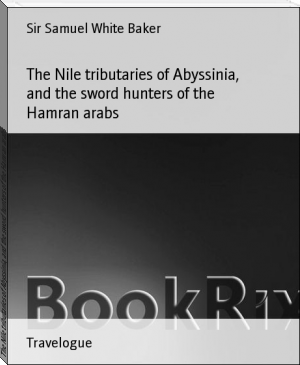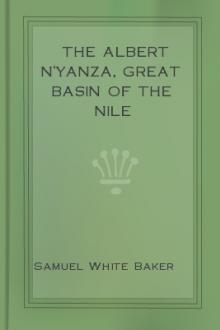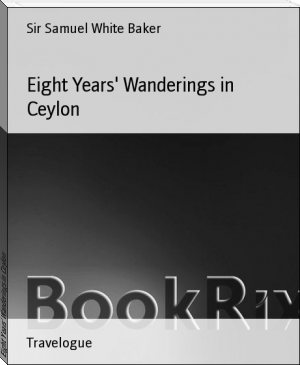The Nile tributaries of Abyssinia, and the sword hunters of the Hamran arabs by Sir Samuel White Baker (e book reader online .TXT) 📕

- Author: Sir Samuel White Baker
Book online «The Nile tributaries of Abyssinia, and the sword hunters of the Hamran arabs by Sir Samuel White Baker (e book reader online .TXT) 📕». Author Sir Samuel White Baker
ariel (G. Dama), and, upon arriving at a deep pool in the river, I shot a bull hippopotamus, as a present for Taher Sheriff and his brothers. We decided upon encamping at a spot known to the Arabs as Delladilla; this was the forest upon the margin of the river where I had first shot the bull elephant, when the aggageers fought with him upon foot. The trees were larger in this locality than elsewhere, as a great portion of the country was flooded by the river dnring the rainy season, and much rich soil had been deposited; this, with excessive moisture, had produced a forest of fine timber, with an undergrowth of thick nabbuk. We fixed upon a charming spot for a camp, beneath a large tree that bore a peculiar fruit, suspended from the branches by a strong but single fibre, like a cord; each fruit was about eighteen inches in length, by six in diameter; it was perfectly worthless, but extremely ornamental. We had arrived beneath this tree, and were still on horseback; my wife had just suggested that it would be unpleasant should one of the large fruit fall upon our heads if we camped under the branches, when suddenly a lioness glided by us, within three yards of the horses, and almost immediately disappeared in the thick thorns; unfortunately, I had the moment before given my rifle to a servant, prior to dismounting. I searched the bushes in every direction, but to no purpose.
This spot was so favourably situated that I determined to remain for some time, as I could explore the country on horseback to a great distance upon all sides. We immediately set to work to construct our new camp, and by the evening our people had cleared a circle of fifty yards diameter; this was swept perfectly clean, and the ground being hard, though free from stones, the surface was as even as a paved floor. The entire circle was well protected with a strong fence of thorn bushes, for which the kittar is admirably adapted; the head being mushroom-shaped, the entire tree is cut down, and the stem being drawn towards the inside of the camp, the thick and wide-spreading thorny crest covers about twelve feet of the exterior frontage; a fence thus arranged is quickly constructed, and is quite impervious. Two or three large trees grew within the camp; beneath the shade of this our tent was pitched. This we never inhabited, but it served as an ordinary room, and a protection to the luggage, guns, &c. The horses were well secured within a double circle of thorns, and the goats wandered about at liberty, as they were too afraid of wild animals to venture from the camp: altogether this was the most agreeable spot we had ever occupied; even the night-fires would be perfectly concealed within the dense shade of the nabbuk jungle, thus neither man nor beast would be aware of our presence. We were about a hundred paces distant from the margin of the river; late in the evening I took my rod, and fished in the deep bend beneath a cliff of conglomerate pebbles. I caught only one fish, a baggar, about twelve pounds, but I landed three large turtles; these creatures were most determined in taking the bait; they varied in size from fifty to about ninety pounds, and were the same species as that which inhabits the Nile (Trionis Nilotica). From one of them we took upwards of a hundred eggs which we converted into omelettes, but they were rather strong in flavour.
Although this species of turtle is unprepossessing in appearance, having a head very like that of a snake, with a dark green shell spotted with yellow, it produces excellent soup; the body is exceedingly flat, and the projecting edges of the shell are soft; it runs extremely fast upon the shore, and is suggestive of the tortoise that beat the hare in the well-known race. Throughout the Nile and its tributaries there are varieties of fish and reptiles closely connected, and the link can be distinctly traced in the progression of development. There is a fish with a hard bony frame, or shell, that includes the head, and extends over more than half the body; this has two long and moveable spikes beneath the fore fins, upon which it can raise itself as upon legs when upon the land; when first caught, this fish makes a noise something like the mewing of a cat: this appears to be closely linked to the tortoise. The Lepidosiren Annectens, found in the White Nile, is a link between the fish and the frog; and certain varieties of mud fish that remain alive throughout a dry season in the sun-baked earth, and reappear with the following rains exhibit a close affinity to reptiles.
On the morning after our arrival, I started to explore the country with the aggageers, and rode about forty miles, From this point, hills of basalt and granite commenced, connected by rugged undulations of white quartz, huge blocks of which were scattered upon the surface; in many of these I found thin veins of galena.
All the rocks were igneous; we had left the sandstone that had marked the course of the Atbara and the valley of the Settite as far as Ombrega, and I was extremely puzzled to account for the presence of the pure white and rose-coloured limestone that we had found only in one place--Geera. As we were now among the hills and mountains, the country was extremely beautiful; at the farthest point of that day's excursion we were close to the high range from which, in the rainy season, innumerable torrents pour into the Settite; some of these gorges were ornamented with the dark foliage of large tamarind trees, while upon rocks that did not appear to offer any sustenance, the unsightly yet mighty baobab* grasped with its gnarled roots the blocks of granite, and formed a peculiar object in the wild and rugged scenery.
* The largest baobab (Adansonia digitata) that I have
measured was fifty-one feet and one inch in circumference.
Through this romantic wilderness, the Settite flowed in a clear and beautiful stream, sometimes contracted between cliffs to a width of a hundred yards, at others stretching to three times that distance. The hippopotami were in great numbers; many were lying beneath the shady trees upon the banks, and splashed into the water as we appeared; others were basking in large herds upon the shallows; while the young calves, supported upon the backs of their mothers, sailed about upon their animated rafts in perfect security. The Base had been here recently, as we discovered their footprints upon the sand, and we arrived at some tobacco plantations that they had formed upon the sandbanks of the river. The aggageers expressed their determination to sabre them should we happen to meet, and were much displeased at my immediately placing a veto upon their bloody intentions, with a reservation for necessity in self-defence.
The Base were far too wide awake, and, although seen once during the day by my people, they disappeared like monkeys; their spies had doubtless reported our movements ever since we had entered their country, and, fearing the firearms, they had retreated to their fastnesses among the mountains.
During the day's march we had seen a large quantity of game, but I had not wished to shoot until on our return towards the camp. We were about four miles from home, when a nellut (A. Strepsiceros) bounded away from a ravine. I was riding Tetel, whom I had taught to stand fire, in which he was remarkably steady. I made a quick shot with the little Fletcher from the saddlle; but, as the nellut ran straight before me, the bullet struck the haunch: away went the aggageers after the wounded animal, like greyhounds, and in a few hundred yards the sword finished the hunt.
The Nellut is the handsomest of all the large antelopes; the male is about thirteen hands high, and carries a pair of beautiful spiral horns, upwards of three feet in length; the colour of the hide is a dark mouse-grey, ornamented with white stripes down the flanks, and a white line along the back from the shoulder to the tail. The female is without horns, but is in other respects similar to the male. These beautiful animals do not inhabit the plains like the other varieties of antelopes, but are generally found in deep-wooded ravines. In South Africa it is known as the koodoo.
The aggageers quickly flayed and quartered the game, which was arranged upon the horses, and thus it was carried to our camp, at which we arrived late in the evening.
On the following morning, at my usual hour of starting, a little before sunrise, we crossed a deep portion of the river, through which the horses were obliged to swim; on this occasion I rode Aggahr, who was my best hunter. In that very charming and useful book by Mr. Francis Galton, "The Art of Travel," advice is given for crossing a deep river, by holding to the tail of the swimming horse. In this I cannot agree; the safety of the man is much endangered by the heels of the horse, and his security depends upon the length of the animal's tail. In rivers abounding in crocodiles, which generally follow an animal before they seize, the man hanging on to the tail of the horse is a most alluring bait, and he would certainly be taken, should one of these horrible monsters be attracted to the party. I have always found great comfort in crossing a river by simply holding to the mane, just in front of the saddle, with my left hand, with the bridle grasped as loosely as possible, so that the horse does not feel the bit; in this position, on the off side, the animal does not feel any hindrance; the man not only can direct his horse, but his presence gives it confidence, as he can speak to it coaxingly while swimming with one arm by its side. Upon landing, he at once controls the horse by the reins within his left grasp.
Many horses become exceedingly scared in swimming a rapid river, and will frequently lose their presence of mind, and swim with the current, in which case they may miss the favourable landing place; if the man holds by the tail, he has no control over the horse upon landing, and, if wild or vicious, the animal will probably kick up its heels and bolt away, leaving the unfortunate proprietor helpless. In swimming a river with the horse, the powder, &c. should be made into a parcel with your outer garment, and tied upon the head; then lead your horse gently into the water, and for a moment allow it to drink, to prevent all shyness; continue to lead it until you lose your depth, when, by holding with your left hand to the mane, both horse and man will cross with perfect ease.
We had crossed the river, and, as we passed through an opening in the belt of jungle on the banks, and entered upon a plain interspersed with clumps of bush, we perceived, at about two hundred yards distance, a magnificent lion, whose shaggy yellow mane gave him a colossal appearance, as he stalked quietly along the flat sandy ground towards the place of his daily retreat. The aggageers whispered, "El Assut!" (the lion), and instinctively the swords flashed from their sheaths. In an instant, the horses were at full speed sweeping over the level ground. The lion had not observed us; but, upon hearing the sound of the hoofs, he halted and raised his head, regarding us for a moment with wonder, as we rapidly
This spot was so favourably situated that I determined to remain for some time, as I could explore the country on horseback to a great distance upon all sides. We immediately set to work to construct our new camp, and by the evening our people had cleared a circle of fifty yards diameter; this was swept perfectly clean, and the ground being hard, though free from stones, the surface was as even as a paved floor. The entire circle was well protected with a strong fence of thorn bushes, for which the kittar is admirably adapted; the head being mushroom-shaped, the entire tree is cut down, and the stem being drawn towards the inside of the camp, the thick and wide-spreading thorny crest covers about twelve feet of the exterior frontage; a fence thus arranged is quickly constructed, and is quite impervious. Two or three large trees grew within the camp; beneath the shade of this our tent was pitched. This we never inhabited, but it served as an ordinary room, and a protection to the luggage, guns, &c. The horses were well secured within a double circle of thorns, and the goats wandered about at liberty, as they were too afraid of wild animals to venture from the camp: altogether this was the most agreeable spot we had ever occupied; even the night-fires would be perfectly concealed within the dense shade of the nabbuk jungle, thus neither man nor beast would be aware of our presence. We were about a hundred paces distant from the margin of the river; late in the evening I took my rod, and fished in the deep bend beneath a cliff of conglomerate pebbles. I caught only one fish, a baggar, about twelve pounds, but I landed three large turtles; these creatures were most determined in taking the bait; they varied in size from fifty to about ninety pounds, and were the same species as that which inhabits the Nile (Trionis Nilotica). From one of them we took upwards of a hundred eggs which we converted into omelettes, but they were rather strong in flavour.
Although this species of turtle is unprepossessing in appearance, having a head very like that of a snake, with a dark green shell spotted with yellow, it produces excellent soup; the body is exceedingly flat, and the projecting edges of the shell are soft; it runs extremely fast upon the shore, and is suggestive of the tortoise that beat the hare in the well-known race. Throughout the Nile and its tributaries there are varieties of fish and reptiles closely connected, and the link can be distinctly traced in the progression of development. There is a fish with a hard bony frame, or shell, that includes the head, and extends over more than half the body; this has two long and moveable spikes beneath the fore fins, upon which it can raise itself as upon legs when upon the land; when first caught, this fish makes a noise something like the mewing of a cat: this appears to be closely linked to the tortoise. The Lepidosiren Annectens, found in the White Nile, is a link between the fish and the frog; and certain varieties of mud fish that remain alive throughout a dry season in the sun-baked earth, and reappear with the following rains exhibit a close affinity to reptiles.
On the morning after our arrival, I started to explore the country with the aggageers, and rode about forty miles, From this point, hills of basalt and granite commenced, connected by rugged undulations of white quartz, huge blocks of which were scattered upon the surface; in many of these I found thin veins of galena.
All the rocks were igneous; we had left the sandstone that had marked the course of the Atbara and the valley of the Settite as far as Ombrega, and I was extremely puzzled to account for the presence of the pure white and rose-coloured limestone that we had found only in one place--Geera. As we were now among the hills and mountains, the country was extremely beautiful; at the farthest point of that day's excursion we were close to the high range from which, in the rainy season, innumerable torrents pour into the Settite; some of these gorges were ornamented with the dark foliage of large tamarind trees, while upon rocks that did not appear to offer any sustenance, the unsightly yet mighty baobab* grasped with its gnarled roots the blocks of granite, and formed a peculiar object in the wild and rugged scenery.
* The largest baobab (Adansonia digitata) that I have
measured was fifty-one feet and one inch in circumference.
Through this romantic wilderness, the Settite flowed in a clear and beautiful stream, sometimes contracted between cliffs to a width of a hundred yards, at others stretching to three times that distance. The hippopotami were in great numbers; many were lying beneath the shady trees upon the banks, and splashed into the water as we appeared; others were basking in large herds upon the shallows; while the young calves, supported upon the backs of their mothers, sailed about upon their animated rafts in perfect security. The Base had been here recently, as we discovered their footprints upon the sand, and we arrived at some tobacco plantations that they had formed upon the sandbanks of the river. The aggageers expressed their determination to sabre them should we happen to meet, and were much displeased at my immediately placing a veto upon their bloody intentions, with a reservation for necessity in self-defence.
The Base were far too wide awake, and, although seen once during the day by my people, they disappeared like monkeys; their spies had doubtless reported our movements ever since we had entered their country, and, fearing the firearms, they had retreated to their fastnesses among the mountains.
During the day's march we had seen a large quantity of game, but I had not wished to shoot until on our return towards the camp. We were about four miles from home, when a nellut (A. Strepsiceros) bounded away from a ravine. I was riding Tetel, whom I had taught to stand fire, in which he was remarkably steady. I made a quick shot with the little Fletcher from the saddlle; but, as the nellut ran straight before me, the bullet struck the haunch: away went the aggageers after the wounded animal, like greyhounds, and in a few hundred yards the sword finished the hunt.
The Nellut is the handsomest of all the large antelopes; the male is about thirteen hands high, and carries a pair of beautiful spiral horns, upwards of three feet in length; the colour of the hide is a dark mouse-grey, ornamented with white stripes down the flanks, and a white line along the back from the shoulder to the tail. The female is without horns, but is in other respects similar to the male. These beautiful animals do not inhabit the plains like the other varieties of antelopes, but are generally found in deep-wooded ravines. In South Africa it is known as the koodoo.
The aggageers quickly flayed and quartered the game, which was arranged upon the horses, and thus it was carried to our camp, at which we arrived late in the evening.
On the following morning, at my usual hour of starting, a little before sunrise, we crossed a deep portion of the river, through which the horses were obliged to swim; on this occasion I rode Aggahr, who was my best hunter. In that very charming and useful book by Mr. Francis Galton, "The Art of Travel," advice is given for crossing a deep river, by holding to the tail of the swimming horse. In this I cannot agree; the safety of the man is much endangered by the heels of the horse, and his security depends upon the length of the animal's tail. In rivers abounding in crocodiles, which generally follow an animal before they seize, the man hanging on to the tail of the horse is a most alluring bait, and he would certainly be taken, should one of these horrible monsters be attracted to the party. I have always found great comfort in crossing a river by simply holding to the mane, just in front of the saddle, with my left hand, with the bridle grasped as loosely as possible, so that the horse does not feel the bit; in this position, on the off side, the animal does not feel any hindrance; the man not only can direct his horse, but his presence gives it confidence, as he can speak to it coaxingly while swimming with one arm by its side. Upon landing, he at once controls the horse by the reins within his left grasp.
Many horses become exceedingly scared in swimming a rapid river, and will frequently lose their presence of mind, and swim with the current, in which case they may miss the favourable landing place; if the man holds by the tail, he has no control over the horse upon landing, and, if wild or vicious, the animal will probably kick up its heels and bolt away, leaving the unfortunate proprietor helpless. In swimming a river with the horse, the powder, &c. should be made into a parcel with your outer garment, and tied upon the head; then lead your horse gently into the water, and for a moment allow it to drink, to prevent all shyness; continue to lead it until you lose your depth, when, by holding with your left hand to the mane, both horse and man will cross with perfect ease.
We had crossed the river, and, as we passed through an opening in the belt of jungle on the banks, and entered upon a plain interspersed with clumps of bush, we perceived, at about two hundred yards distance, a magnificent lion, whose shaggy yellow mane gave him a colossal appearance, as he stalked quietly along the flat sandy ground towards the place of his daily retreat. The aggageers whispered, "El Assut!" (the lion), and instinctively the swords flashed from their sheaths. In an instant, the horses were at full speed sweeping over the level ground. The lion had not observed us; but, upon hearing the sound of the hoofs, he halted and raised his head, regarding us for a moment with wonder, as we rapidly
Free e-book «The Nile tributaries of Abyssinia, and the sword hunters of the Hamran arabs by Sir Samuel White Baker (e book reader online .TXT) 📕» - read online now
Similar e-books:





Comments (0)